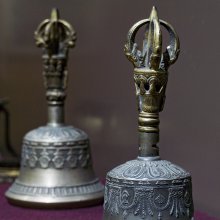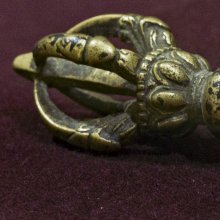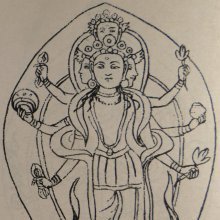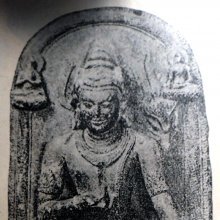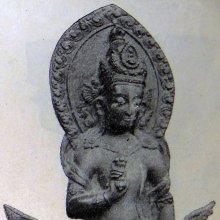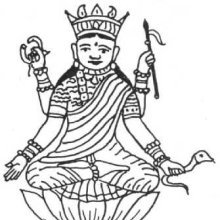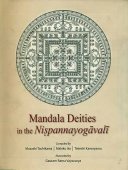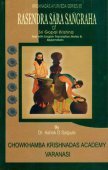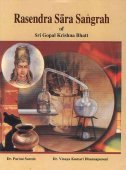Vajra, Vajrā: 55 definitions
Introduction:
Vajra means something in Buddhism, Pali, Hinduism, Sanskrit, Jainism, Prakrit, the history of ancient India, Marathi, Hindi, biology. If you want to know the exact meaning, history, etymology or English translation of this term then check out the descriptions on this page. Add your comment or reference to a book if you want to contribute to this summary article.
Images (photo gallery)
(+109 more images available)
In Hinduism
Shilpashastra (iconography)
Source: Google Books: The Theory of Citrasutras in Indian PaintingVajra (वज्र, ‘thunderbolt’) is a weapon (āyudha or bādhra) according to the Vāstusūtra Upaniṣad.
Source: Google Books: Elements of Hindu iconographyVajra is the thunder-bolt. This has a long history beginning from the Buddhistic period. In later Hindu mythology, it is shown in almost the same form which it had in earlier times. It is made up of two similar limbs, each having three claws resembling the claws of birds; and both its parts are connected together by the handle in the middle.
Source: Red Zambala: Hindu Icons and Symbols | IntroductionVajra (Thunderbolt) - Diamond wisdom — the ultimate truth as adamantine and indestructible, but which destroys all that is other than truth. Symbol of sovereignty and the Cosmic Order.
Source: Shodhganga: The significance of the mūla-beras (śilpa)1) Vajra (वज्र) refers to “diamonds” and represents a kind of precious stone (gem) used for the making of images (Hindu icons), as defined in the texts dealing with śilpa (arts and crafs), known as śilpaśāstras.—The materials listed in the Āgamas for the making of images are wood, stone, precious gems, metals, terracotta, laterite, earth, and a combination of two or three or more of the materials specified above. The precious stones mentioned in the Āgamas for the purpose of making images are [for example] vajra (diamonds).
Precious stones (e.g., vajra or ‘diamonds’) are preferred materials for fashioning images.—The materials recommended in the śilpaśāstra for the fashioning of images are unburnt clay, burnt clay as in brick or terracotta, sudhā (a special kind of mortar/plaster), composite earth, wood, stone, metal, ivory, dhātu (mineral), pigment, and precious stones. Wood is considered superior to earth, stone as better than wood, metal better than stone, and precious stone (such as vajra) is the most preferred of all.
2) Vajra (वज्र) refers to the “thunderbolt” or “two-headed śūla” and represents one of the several “attributes” (āyudha) or “accessories” of a detiy commonly seen depicted in Hindu iconography, defined according to texts dealing with śilpa (arts and crafs), known as śilpaśāstras.—Vajra is the thunderbolt. It is made up of two similar limbs, each having three claws resembling the claws of birds and both its parts are connected together by the handle in the middle.
Vajra also represents “mulumai” (wholeness), one of the attributes of Lord Śiva.
Source: Shodhganga: Elements of Art and Architecture in the Trtiyakhanda of the Visnudharmottarapurana (shilpa)The Vajra is associated with Śakra (Indra), whose iconography is described in the Viṣṇudharmottarapurāṇa, an ancient Sanskrit text which (being encyclopedic in nature) deals with a variety of cultural topics such as arts, architecture, music, grammar and astronomy.—Along with the image of Indra, the statue of his wife Śacī is also placed. The idol of Indra should have four hands holding a lotus and an elephant goad in right hands and the vajra in the left hand. Another hand of left side should be placed behind the idol of his wife. Thus it is clear that the Viṣṇudharmottarapurāṇa offers a great field of knowledge regarding the nuances of Indian art of Image making [e.g., the vajra] during 10th–11th century A.D.

Shilpashastra (शिल्पशास्त्र, śilpaśāstra) represents the ancient Indian science (shastra) of creative arts (shilpa) such as sculpture, iconography and painting. Closely related to Vastushastra (architecture), they often share the same literature.
Purana and Itihasa (epic history)
Source: Google Books: Cultural History from the Vāyu PurānaVajra (वज्र):—It is mentioned in the Ṛgveda mostly as a weapon of Indra. It is suggested that it was originally made of stone and later of bone. In later literature its use as a weapon becomes rare. The Vāyu-purāṇa uses it mostly in connection with Indra and Śiva. It, however, shows a stage when vajra as a weapon was proably no longer in use and the term was often metaphorically used.
Source: archive.org: Puranic Encyclopedia1) Vajra (वज्र).—Son of Viśvāmitra. He was an expounder of Vedas. (Mahābhārata Anuśāsana Parva, Chapter 4, Stanza 52).
2) Vajra (वज्र).—The son of Aniruddha, who was the grandson of Śrī Kṛṣṇa. Mention is made in Mahābhārata, Mausala Parva, Chapter 7, Stanza 72, that after the extermination of the Yādavas by the mausala fight (the fight with grass grown from the filings of the iron-pestle), Arjuna anointed Vajra as the King of the remaining Yādavas. When the Pāṇḍavas began the Mahāprasthāna (the great departure), Yudhiṣṭhira called Subhadrā and instructed her to look after Vajra with particular care. (Mahābhārata Mahā Prasthāna Parva, Chapter 1, Stanza 8).
3) Vajra (वज्र) or Vajravyūha refers to the “Disposition of an army in the shape of a diamond”.—Disposition of an army (vyūha) of four parts, (infantry, cavalry, elephants and chariots) in the battlefield, the arrangement of it, in various forms. It is said that during the period of Mahābhārata, there were various forms of disposition of the army.—Vajra-vyūha is mentioned in the Mahābhārata Bhīṣma Parva, Chapter 81.
Source: archive.org: Shiva Purana - English Translation1) Vajra (वज्र) refers to “diamond”, representing the material of Vibhāvasu’s liṅga, according to the Śivapurāṇa 2.1.12.—Accoridngly, as the Devas requested Viśvakarman for Liṅgas:—“[...] At our bidding Viśvakarmā made liṅgas and gave them to the devas according to their status. [...] Goddess Lakṣmī took a crystal liṅga. The Ādityas (the twelve suns) took liṅgas made of copper. The Moon took a liṅga made of pearl and the god of fire (Vibhāvasu) took a liṅga of diamond (Vajra-liṅga). [...] Thus different kinds of liṅgas were given to them by Viśvakarmā which the devas and the celestial sages worship regularly. [...]”.
2) Vajra (वज्र) refers to a “steel-set” (city), according to the Śivapurāṇa 2.5.1 (“Description of Tripura—the three cities”).—Accordingly, as the sons of Tāraka-Asura said to Brahmā: “[...] O Preceptor of the universe, Lord of the worlds, by your grace we shall move about on the earth occupying these cities. Tārakākṣa then said—‘Let Viśvakarmā make a city which cannot be broken even by the gods. Let that golden city be mine’. Kamalākṣa requested for a great silver city. The delighted Vidyunmālī requested for a steel-set (vajra) magnetic city [vajrāyasamayaṃ mahat]. [...]”.
Source: Cologne Digital Sanskrit Dictionaries: The Purana Index1a) Vajra (वज्र).—Indra's thunderbolt; a weapon shaped out of Dadhīci's limbs by Viśvakarman for the use of Indra; with this Indra was able to break the back of the mountains. By this Vṛtra was slain. But it was of no use against Namuci; the embodiment of Brahmanical energy;1 from the tejas of the sun;2 a weapon of war;3 in the battle with Kṛṣṇa.4
- 1) Bhāgavata-purāṇa VI. 10. 13; VIII. 11. 33-36; Matsya-purāṇa 7. 55; Vāyu-purāṇa 30. 235; 67. 103; 78. 53; Viṣṇu-purāṇa V. 20. 41.
- 2) Brahmāṇḍa-purāṇa III. 5. 69; IV. 19. 76 and 85; 37. 17. Matsya-purāṇa 11. 29.
- 3) Ib. 135. 37, 54; 160. 9; 162. 31; 174. 42; 177. 13.
- 4) Viṣṇu-purāṇa V. 30. 69; 31. 4.
1b) A son of Aniruddha and Subhadrā, and father of Pratibāhu: Installed king of Śūrasenas at Mathurā by Yudhiṣṭhira after Arjuna crowned him at Indraprastha after the decease of Kṛṣṇa.*
- * Bhāgavata-purāṇa X. 90. 37-38; I. 15. 39; XI. 31. 25; Viṣṇu-purāṇa IV. 15. 41-2; V. 32. 6; 37. 63-65.
1c) A thief of Kāñcī stole bit by bit from the city and stored the riches in a secret place in the neighbouring woods. A certain kirāta gathering fuel for sale observed this once and took a portion of the property home. His wife, charitably disposed, wanted to utilise it for digging wells and ponds. So a pond was constructed but before it was completed, all money had been spent. He got more of the thief's wealth and completed the embankment; built temples of Śiva and Viṣṇu, besides giving gifts to Brāhmaṇas who were pleased and renamed him and his wife as Dvijavarma and Śīlāvatī: He also built a town and named it after his Purohita, Devarāta. At his death, as he built all out of stolen wealth Nārada ruled that he should wander in air for 12 years, while his wife went to Brahmaloka. As she refused, she was advised to recite śatarudra and get her husband released from the sin of theft. When Vajra died he got half of Dvijavarman's virtue. Dvijavarman attained Kailāsa.*
- * Brahmāṇḍa-purāṇa IV. 7. 10-61.
1d) A son of Upasanga.*
- * Matsya-purāṇa 47. 22.
1e) A son of Aśvasuta and Sutanu.*
- * Vāyu-purāṇa 96. 251; 109. 3.
2a) Vajrā (वज्रा).—A Varṇa Śakti.*
- * Brahmāṇḍa-purāṇa IV. 44. 60.
2b) A R. sacred to Lalitā.*
- * Brahmāṇḍa-purāṇa IV. 33. 29-33.
Vajra (वज्र) is a name mentioned in the Mahābhārata (cf. XIII.4.51, XIII.4) and represents one of the many proper names used for people and places. Note: The Mahābhārata (mentioning Vajra) is a Sanskrit epic poem consisting of 100,000 ślokas (metrical verses) and is over 2000 years old.
Vajra also refers to the name of a Weapon mentioned in the Mahābhārata (cf. I.29.19).

The Purana (पुराण, purāṇas) refers to Sanskrit literature preserving ancient India’s vast cultural history, including historical legends, religious ceremonies, various arts and sciences. The eighteen mahapuranas total over 400,000 shlokas (metrical couplets) and date to at least several centuries BCE.
Ayurveda (science of life)
Rasashastra (Alchemy and Herbo-Mineral preparations)
Source: Wisdom Library: Rasa-śāstraVajra (वज्र, “Diamond”):—One of the nine gems (navaratna) according to the 13th century Rasaprakāśasudhākara. It also known by the name Hirāka (हिराक).
It has several variations, such as:
- Puṃvajra (man, or, nara),
- Strīvajra (woman, or, nārī),
- and Napuṃsakavajra (neuter).
The diamonds of the same gender may be used the same gender person. If used otherwise means in different genders it may not give desired results except male diamonds. In the same way the diamonds of the same caste may be used in the same caste persons. This ruling is given by the lord ‘Bhairava’ and is applicable in the case of ratna group of drugs.
The Diamond (vajra) has Pharmaco-therapeutic properties and the vajra-bhasma is capable of destroying the prakopa of all the three doṣas, it is considered to give the āyu (longevity) and also considered as vṛṣyatama (best aphrodisiac). It always proves bandhakara (solidyfire) of rasendra (mercury) and may prevent the untimely death like that of śudhā (amṛta/nectar)
Source: Indian Journal of History of Science, 31(4), 1996: MūṣāvijñānaVajra (वज्र) or Vajramūṣā refers to an “diamond crucible” and is a type of mūṣā (crucible) used for smelting metals.—Vajra-mūṣā was a specially made hard-crucible which contained specific proportion of the above ingredients. It was used for extraction of metals from ores, where moderate temperatures are needed. Also see Rasaratnasamuccaya 5.171, 230 and Rasārṇava 14.151.
Nighantu (Synonyms and Characteristics of Drugs and technical terms)
Source: WorldCat: Rāj nighaṇṭuVajra (वज्र) is another name for Kokilākṣa, a medicinal plant identified with Astercantha longifolia Nees., a synonym of synonym of Hygrophila auriculata (Schumach.) Heine from the Acanthaceae or “acanthus” family of flowering plants, according to verse 4.191-193 of the 13th-century Raj Nighantu or Rājanighaṇṭu. The fourth chapter (śatāhvādi-varga) of this book enumerates eighty varieties of small plants (pṛthu-kṣupa). Together with the names Vajra and Kokilākṣa, there are a total of fourteen Sanskrit synonyms identified for this plant.
Unclassified Ayurveda definitions
Source: Wisdom Library: Āyurveda and botanyVajrā (वज्रा) is another name for Balāka, which is a Sanskrit word referring to Pavonia odorata (fragement mallow plant), from the Malvaceae family. It is classified as a medicinal plant in the system of Āyurveda (science of Indian medicine) and is used throughout literature such as the Suśrutasaṃhita and the Carakasaṃhitā.
Source: gurumukhi.ru: Ayurveda glossary of termsVajra (वज्र):—[vajraṃ] Diamond.

Āyurveda (आयुर्वेद, ayurveda) is a branch of Indian science dealing with medicine, herbalism, taxology, anatomy, surgery, alchemy and related topics. Traditional practice of Āyurveda in ancient India dates back to at least the first millenium BC. Literature is commonly written in Sanskrit using various poetic metres.
Natyashastra (theatrics and dramaturgy)
Source: Wisdom Library: Nāṭya-śāstra1) Vajra (वज्र) is a Sanskrit word referring to “thunderbolt”, the destroyer of daityas (demons). Acording to the Nāṭyaśāstra 1.82-88, when Brahmā, Indra and all other gods went to inspect the playhouse (nāṭyamaṇḍapa) designed by Viśvakarmā, he assigned different deities for the protection of the playhouse itself, as well as for the objects relating to dramatic performance (prayoga).
As such, Brahmā assigned Vajra to the Jarjara (Indra’s banner staf). The protection of the playhouse was enacted because of the jealous Vighnas (malevolent spirits), who began to create terror for the actors.
2) Vajra is to be worshipped during raṅgapūjā, according to the Nāṭyaśāstra 3.1-8. Accordingly, the master of the dramatic art who has been initiated for the purpose shall consecrate the playhouse after he has made obeisance (e.g., to Vajra).
3) Vajra (वज्र) is a Sanskrit word referring to a “diamond”. When constructing the plinth of the stage (raṅgaśīrṣa), of a playhouse (nāṭyamaṇḍapa), there should be jewels and precious stones be placed underneath by expert builders, according to the Nāṭyaśāstra 2.72-74. Accordingly, diamond (vajra) is to be put in the east (pūrva).
4) Vajra (वज्र, “thunderbolt”) refers to ‘an adamant’: blunt response made to the face. Vajra represents one of the thirteen pratimukhasandhi, according to the Nāṭyaśāstra chapter 21. Pratimukhasandhi refers to the “segments (sandhi) of the progressing part (pratimukha)” and represents one of the five segments of the plot (itivṛtta or vastu) of a dramatic composition (nāṭaka).
(Description of Vajra): “harsh words uttered on one’s face is called thunderbolt (vajra)”.
5) Vajra (वज्र) refers to one of the four limbs (aṅga) belonging to Prāveśikī type of song (dhruvā) defined in the Nāṭyaśāstra chapter 32.9-16. Accordingly, “depending on different conditions, the dhruvās are known to be of five classes”.

Natyashastra (नाट्यशास्त्र, nāṭyaśāstra) refers to both the ancient Indian tradition (shastra) of performing arts, (natya—theatrics, drama, dance, music), as well as the name of a Sanskrit work dealing with these subjects. It also teaches the rules for composing Dramatic plays (nataka), construction and performance of Theater, and Poetic works (kavya).
Vaishnavism (Vaishava dharma)
Source: ISKCON Press: GlossaryVajra (वज्र).—The great grandson of Lord Śrī Kṛṣṇa. He became the king of Mathurā when Lord Kṛṣṇa left this world.

Vaishnava (वैष्णव, vaiṣṇava) or vaishnavism (vaiṣṇavism) represents a tradition of Hinduism worshipping Vishnu as the supreme Lord. Similar to the Shaktism and Shaivism traditions, Vaishnavism also developed as an individual movement, famous for its exposition of the dashavatara (‘ten avatars of Vishnu’).
Dhanurveda (science of warfare)
Source: Wisdom Library: DhanurvedaVajra (वज्र) refers to a weapon (“thunderbolt”). It is a Sanskrit word defined in the Dhanurveda-saṃhitā, which contains a list of no less than 117 weapons. The Dhanurveda-saṃhitā is said to have been composed by the sage Vasiṣṭha, who in turn transmitted it trough a tradition of sages, which can eventually be traced to Śiva and Brahmā.
The vajra should measure should measure four tālas (unit of measurement), according to Nāṭyaśāstra chapter 23. In dramatic plays, weapons such as vajra should be made by experts using proper measurements and given to persons engaged in a fight, angry conflict or siege. It forms a component of āhāryābhinaya (extraneous representation).
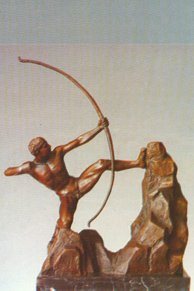
Dhanurveda (धनुर्वेद) refers to the “knowledge of warfare” and, as an upaveda, is associated with the Ṛgveda. It contains instructions on warfare, archery and ancient Indian martial arts, dating back to the 2nd-3rd millennium BCE.
Chandas (prosody, study of Sanskrit metres)
Source: Shodhganga: a concise history of Sanskrit Chanda literatureVajra (वज्र) is the name of a Sanskrit metre (chandas) to which Hemacandra (1088-1173 C.E.) assigned the alternative name of Madhu-karikā in his auto-commentary on the second chapter of the Chandonuśāsana. Hemacandra gives these alternative names for the metres by other authorities (like Bharata), even though the number of gaṇas or letters do not differ.

Chandas (छन्दस्) refers to Sanskrit prosody and represents one of the six Vedangas (auxiliary disciplines belonging to the study of the Vedas). The science of prosody (chandas-shastra) focusses on the study of the poetic meters such as the commonly known twenty-six metres mentioned by Pingalas.
Shaivism (Shaiva philosophy)
Source: Shodhganga: Temple management in the ĀgamasVajra (वज्र) refers to one of the various Devatā weapons and represents a type of “temple implement (instrument)” as described in the Karaṇalakṣaṇavidhi-paṭala section of the Uttara-Kāmikāgama.—The instruments should be according to the particular śāstra followed at the temple. Some of the instruments mentioned are weapons of all Devatās including [viz., vajra].

Shaiva (शैव, śaiva) or Shaivism (śaivism) represents a tradition of Hinduism worshiping Shiva as the supreme being. Closely related to Shaktism, Shaiva literature includes a range of scriptures, including Tantras, while the root of this tradition may be traced back to the ancient Vedas.
Kavya (poetry)
Source: OpenEdition books: Vividhatīrthakalpaḥ (Kāvya)Vajra (वज्र) or Vajrasvāmin is the name of a teacher, as mentioned in the Vividhatīrthakalpa by Jinaprabhasūri (13th century A.D.): an ancient text devoted to various Jaina holy places (tīrthas).—Accordingly, “Rukmiṇī has longed to become the wife of Master Vajra since the day she heard the nuns sing his praises. As a result, when the Master comes to Pāṭaliputra, the merchant Dhana, father of Rukmiṇī, offers Vajra his daughter and a considerable dowry. The Master declines the offer and converts Rukmiṇī to Jainism”.
Cf. Pariśistaparvan (or Sthavirāvalīcarita) XII. v. 292-306.

Kavya (काव्य, kavya) refers to Sanskrit poetry, a popular ancient Indian tradition of literature. There have been many Sanskrit poets over the ages, hailing from ancient India and beyond. This topic includes mahakavya, or ‘epic poetry’ and natya, or ‘dramatic poetry’.
Shaktism (Shakta philosophy)
Source: Google Books: ManthanabhairavatantramVajra (वज्र) refers to the “thunderbolt” and as one of the weapons (attributes) of Goddess Kubjikā symbolizes “the destruction of all diseases”, according to the Manthānabhairavatantra, a vast sprawling work that belongs to a corpus of Tantric texts concerned with the worship of the goddess Kubjikā.—Accordingly, “(Now) I will tell (you about) the great weapons of that (goddess) Kubjikā. [...] (One) attains (ultimate) reality by means of the trident and Māyā is destroyed by means of the wheel. All diseases are destroyed by the thunderbolt [i.e., vajra] while the goad is considered to be (the means to attract and) control. The enemy is destroyed by the arrow. The dagger is the avoidance of obstacles. Wealth is acquired by means of the severed head and the eight yogic powers by the ascetic’s staff”.

Shakta (शाक्त, śākta) or Shaktism (śāktism) represents a tradition of Hinduism where the Goddess (Devi) is revered and worshipped. Shakta literature includes a range of scriptures, including various Agamas and Tantras, although its roots may be traced back to the Vedas.
Jyotisha (astronomy and astrology)
Source: Wisdom Library: Brihat Samhita by VarahamihiraVajra (वज्र) refers to “diamonds”, according to the Bṛhatsaṃhitā (chapter 16) (“On the planets—graha-bhaktiyoga”), an encyclopedic Sanskrit work written by Varāhamihira mainly focusing on the science of ancient Indian astronomy astronomy (Jyotiṣa).—Accordingly, “[...] Venus also presides over perfumes, flowers, perfumed paste, gems, diamonds (vajra), ornaments, lotus or conch shells, beds, bridegrooms, young men, young women, objects tending to provoke lustful desires and persons that eat good and sweet meals; over gardens, waters, voluptuaries and lewed men; over fame, comfort, generosity, beauty, and learning, over ministers, merchants, potters, birds and triphala”.

Jyotisha (ज्योतिष, jyotiṣa or jyotish) refers to ‘astronomy’ or “Vedic astrology” and represents the fifth of the six Vedangas (additional sciences to be studied along with the Vedas). Jyotisha concerns itself with the study and prediction of the movements of celestial bodies, in order to calculate the auspicious time for rituals and ceremonies.
Yoga (school of philosophy)
Source: ORA: Amanaska (king of all yogas): A Critical Edition and Annotated Translation by Jason BirchVajra (वज्र) refers to a “thunderbolt”, according to the Śivayogadīpikā, an ancient Sanskrit text dealing with Yoga possibly corresponding to the Śivayoga quoted in Śivānanda’s Yogacintāmaṇi.—Accordingly, [while describing a sequence of Haṭhayoga practices]: “Thus, by means of this Haṭhayoga which has eight auxiliaries, those [students who are] life-long celibates obtain the Siddhis of the [best of Sages] because of their untiring practice. [...] In the fifth year, he has clairaudience, the Siddhi of speech and [the power to] enter the bodies of other [beings]. Within six [years,] he cannot be pierced by even a thunderbolt (vajra), he can move extremely quickly and has clairvoyance. [...]”.

Yoga is originally considered a branch of Hindu philosophy (astika), but both ancient and modern Yoga combine the physical, mental and spiritual. Yoga teaches various physical techniques also known as āsanas (postures), used for various purposes (eg., meditation, contemplation, relaxation).
Vastushastra (architecture)
Source: Shodhganga: Elements of Art and Architecture in the Trtiyakhanda of the Visnudharmottarapurana (vastu)Vajra (वज्र) refers to one of the hundred types of Temples (in ancient Indian architecture), according to the Viṣṇudharmottarapurāṇa, an ancient Sanskrit text which (being encyclopedic in nature) deals with a variety of cultural topics such as arts, architecture, music, grammar and astronomy.—It is quite difficult to say about a definite number of varieties of Hindu temples but in the Viṣṇudharmottarapurāṇa hundred varieties of temples have been enumerated. For example, Vajra. These temples are classified according to the particular shape, amount of storeys and other common elements, such as the number of pavilions, doors and roofs. The Viṣṇudharmottarapurāṇa relates that the temple named Vajra should be constructed in the opposite shape of the Mṛdaṅga (a kind of drum).

Vastushastra (वास्तुशास्त्र, vāstuśāstra) refers to the ancient Indian science (shastra) of architecture (vastu), dealing with topics such architecture, sculpture, town-building, fort building and various other constructions. Vastu also deals with the philosophy of the architectural relation with the cosmic universe.
General definition (in Hinduism)
Source: Wisdom Library: HinduismVajra (वज्र) is a Sanskrit word for a weapon translating to “thunderbolt”. Sculptures or other depictions of Hindu dieties are often seen holden this weapon in their hand.
In Buddhism
Mahayana (major branch of Buddhism)
Source: Wisdom Library: Maha Prajnaparamita Sastra1) Vajra (वज्र) refers to a type of jewel (ratna), into which the universe was transformed by the Buddha’s miraculous power (ṛddhibala) according to the 2nd century Mahāprajñāpāramitāśāstra (chapter XV).
Also, “These jewels (eg, vajra) are of three types, Human jewels (manuṣya-ratna), Divine jewels (divya-ratna) and Bodhisattva jewels (bodhisattva-ratna). These various jewels remove the poverty (dāridrya) and the suffering (duḥkha) of beings”.
2) Vajra (वज्र, “thunderbolt”) according to the 2nd century Mahāprajñāpāramitāśāstra (chapter XLIX).—“The thunderbolt (vajra) at the top of a mountain (giryagra) gradually sinks down to the bottom of the diamond level (vajrabhūmi) and there, rejoining its own element (prakṛti or svabhāva), it stops. It is the same with dharmas: when one analyzes and explores them wisely, one reaches the very center of the tathatā and, on leaving this tathatā, one enters into the intrinsic nature (prakṛti or svabhāva).” (Notes:) The thunderbolt (vajra), cast by the powerful deities, strikes the summit of the mountains, passes through the earth (pṛthivī) and rejoins its natural element, the diamond level (vajrabhūmi) where it dissolves.
3) Vajra (वज्र, “diamond”) according to the chapter 51, “the Bodhisattva must practice the perfection of wisdom if he envisages thus: ‘when I shall have attained supreme complete enligtenment, may every place where I walk, stand, sit or lie down change into diamond (vajra)”. Question.—Why is the earth (pṛthivī) changed into vajra ‘diamond’ where the Buddha takes up the four postures (īryāpatha)?
Answer (a).—[...] For beings the earth is a deception and exists as retribution (vipāka) conditioned by previous actions (karman); this is why it is incapable of supporting the Bodhisattva. When the Bodhisattva is about to realize saṃbodhi, he has knowledge of the true nature (dharmatājñāna) as ‘body’ (kāya), and then the place where he is seated changes into vajra.
Answer (b).—According to others, the Earth (pṛthivī) rests on the Circle of gold; the Circle of gold rest on the vajra; from the upper point of the vajra arises a terrace (prāsāda) similar to a lotus flower (padmapuṣpa); just above, it supports the place where the Bodhisattva is sitting and prevents it from sinking This is why the area of enlightenment (bodhimaṇḍa) where the Bodhisattva sits is called vajra.
Answer (c).—According to yet others, as soon as the Bodhisattva has realized saṃbodhi, every place where the Buddha takes up the four postures (īryāpatha) changes into diamond (vajra).
Source: academia.edu: A Study and Translation of the GaganagañjaparipṛcchāVajra (वज्र) refers to a “diamond”, according to the Gaganagañjaparipṛcchā: the eighth chapter of the Mahāsaṃnipāta (a collection of Mahāyāna Buddhist Sūtras).—Accordingly, “Further, the so-called ‘insight (prajñā)’ is a word for calm because it is free from the flame of false discrimination; [...] a word for penetration because it is well understood; a word for meaning because it is ineffable; a word for sameness because it is without difference; a word for firmness because it is indestructible; a word for no darkness because it is not dependent on anything; a word for diamond (vajra-pada) because it completely pierce [all dharmas], a word for liberation because it has been done what is to be done, [...]”.

Mahayana (महायान, mahāyāna) is a major branch of Buddhism focusing on the path of a Bodhisattva (spiritual aspirants/ enlightened beings). Extant literature is vast and primarely composed in the Sanskrit language. There are many sūtras of which some of the earliest are the various Prajñāpāramitā sūtras.
Tibetan Buddhism (Vajrayana or tantric Buddhism)
Source: Wisdom Library: Tibetan BuddhismVajra (वज्र) refers to one of the various Grahas and Mahāgrahas mentioned as attending the teachings in the 6th century Mañjuśrīmūlakalpa: one of the largest Kriyā Tantras devoted to Mañjuśrī (the Bodhisattva of wisdom) representing an encyclopedia of knowledge primarily concerned with ritualistic elements in Buddhism. The teachings in this text originate from Mañjuśrī and were taught to and by Buddha Śākyamuni in the presence of a large audience (including Vajra).
Source: Google Books: An Esoteric Exposition of the Bardo Thodol Part AVajrā (वज्रा):—One of the six ‘Queens of Yoga’ projecting the rites of enrichment—The yellow bat-headed Vajrā holding a razor occupies the northwest petal of this chakra. The bat lives in dark caves, symbolising relatively unimportant dimly lit chakras. Here a nāḍī to the Liver centre is implied, and represents the flow of prāṇas that are the experiential gain from the field of desire. Generally this gain is relatively inconsequential as far as the development of wisdom is concerned because the person seeks to satiate the objective of desire over and over again. Pleasure is sought, as well as the consequential myriad karma-creating forms of emotional highs and lows. Ignorance is thus perpetuated, hence the bat flies in darkness,
Source: Google Books: VajrayoginiVajra (वज्र).—The vajra is usually red in color, and sometimes described as blazing and adorned with shining streamers. It is generally five-pointed—the four jutting angles plus the central spoke—which are said in the Abhisamayamañjarī to symbolize “the five knowledges combined into one essence”. Vajravārāhī holds it outstretched, pointing her forefinger threateningly at all ignorance and evil. This is a gesture common among wrathful deities, who shake their weapons menacingly so that they become “terrifying even to fear itself”.
Source: academia.edu: The Structure and Meanings of the Heruka MaṇḍalaVajra (वज्र) refers to one of the items held in the right hand of Heruka: one of the main deities of the Herukamaṇḍala described in the 10th century Ḍākārṇava chapter 15. Heruka is positioned in the Lotus (padma) at the center; He is the origin of all heroes; He has 17 faces (with three eyes on each) and 76 arms [holding, for example, vajra]; He is half black and half green in color; He is dancing on a flaming sun placed on Bhairava and Kālarātrī.
Source: OSU Press: Cakrasamvara Samadhi1) Vajra (वज्र) refers to one of the attributes used to describe Cakrasaṃvara, according to the Saṃvaramaṇḍala of Abhayākaragupta’s Niṣpannayogāvalī, p. 45 and n. 145; (Cf. Cakrasaṃvaratantra, Gray, David B., 2007).—Accordingly, [while describing the iconography of Cakrasaṃvara]: “In the Saṃvara Maṇḍala atop Mount Sumera within a vajra-canopy there is a variegated lotus, on top of that a palace, in the middle of which is the Blessed Lord, standing in ālīḍhāsana, "archer's pose", [...] possessing a vyāghracarma, "tiger skin" and twelve arms, the foremost arms holding a vajra and ghaṇṭā, embracing Vajravārāhī, the uppermost arms holding a gajacarman, "elephant skin", [...]”.
Note: The vajra and ghaṇṭā symbolizes mastering the skill (upāya) of wielding emptiness (śūnyatā).
2) Vajra (वज्र) or Vajrakaroṭaka refers to the “Vajra skull bowl” (filled with bodhicitta—the enlightened mind) and represents one of the four Karoṭa or Karoṭaka.—The Cakrasaṃvara-maṇḍala has a total of sixty-two deities. [...] The Four skull cups in the cardinal directions, northeast, northwest, southwest, and southeast. Together with Cakrasaṃvara, Vajravārāhī, and the essence Yoginīs, they make up the jñāna-cakra, "the knowledge wheel". The four skull bowls (karoṭaka) are [e.g., Vajra-karoṭaka—Vajra skull bowl].

Tibetan Buddhism includes schools such as Nyingma, Kadampa, Kagyu and Gelug. Their primary canon of literature is divided in two broad categories: The Kangyur, which consists of Buddha’s words, and the Tengyur, which includes commentaries from various sources. Esotericism and tantra techniques (vajrayāna) are collected indepently.
General definition (in Buddhism)
Source: Wisdom Library: Dharma-samgrahaVajrā (वज्रा) refers to the first of the “six Yoginīs” (ṣaḍyoginī) as defined in the Dharma-saṃgraha (section 13). The Dharma-samgraha (Dharmasangraha) is an extensive glossary of Buddhist technical terms in Sanskrit (e.g., ṣaṣ-yoginī and Vajrā). The work is attributed to Nagarguna who lived around the 2nd century A.D.
Source: Wisdom Library: BuddhismVajra:—Wisdom that is unchanging, like a diamond.
In Jainism
Jain philosophy
Source: archive.org: Anekanta Jaya Pataka of Haribhadra SuriVajra (वज्र) refers to a “diamond”, as occurring in the Anekāntajayapatākā-prakaraṇa, a Śvetāmbara Jain philosophical work written by Haribhadra Sūri.—[Cf. Vol. II, P. 26, l. 7]—‘Vajra’, a homonym, here means a diamond. A diamond and a bhāṇḍa (? bhiṇḍī), though equal in weight, differ in value.
-
General definition (in Jainism)
Source: archive.org: TrisastisalakapurusacaritraVajra (वज्र) or Vajrāsana is the name of a posture (āsana), according to chapter 2.1 [ajitanātha-caritra] of Hemacandra’s 11th century Triṣaṣṭiśalākāpuruṣacaritra: an ancient Sanskrit epic poem narrating the history and legends of sixty-three illustrious persons in Jainism.
Accordingly, “the elephant of kings (i.e., Vimalavāhana) dismounted from the elephant’s shoulder and entered the garden, like a lion a mountain-cave. [...] He saw monks there, too, some in the [viz., vajra-posture, ...] some engaged in kāyotsarga, and some in ukṣa-posture, indifferent to the body, who had carried out their vows in the midst of numerous attacks, like soldiers in battles, victorious over internal enemies, enduring trials, powerful from penance and meditation [...] The King, with devotion sprouted in the guise of horripilation, as it were, approached Ācārya Arindama and paid homage to him”.
Source: The University of Sydney: A study of the Twelve ReflectionsVajra (वज्र) refers to the “thunderbolt (posture)”, according to the 11th century Jñānārṇava, a treatise on Jain Yoga in roughly 2200 Sanskrit verses composed by Śubhacandra.—Accordingly, “On a flat piece of wood or stone, on the ground or on sandy soil, the wise [person] should adopt a stable posture for the accomplishment of absorption. Thus, sitting cross-legged, sitting half cross-legged, thunderbolt (vajra), hero posture and the previously mentioned pleasant and lotus [postures] as well as abandonment of the body is highly thought of. [...]”.

Jainism is an Indian religion of Dharma whose doctrine revolves around harmlessness (ahimsa) towards every living being. The two major branches (Digambara and Svetambara) of Jainism stimulate self-control (or, shramana, ‘self-reliance’) and spiritual development through a path of peace for the soul to progess to the ultimate goal.
India history and geography
Source: Cologne Digital Sanskrit Dictionaries: Indian Epigraphical GlossaryVajra.—(HA), thunderbolt. Cf. vaccira-ppaḍai (SITI), the lower or foundation tier of the wall of a temple. Note: vajra is defined in the “Indian epigraphical glossary” as it can be found on ancient inscriptions commonly written in Sanskrit, Prakrit or Dravidian languages.

The history of India traces the identification of countries, villages, towns and other regions of India, as well as mythology, zoology, royal dynasties, rulers, tribes, local festivities and traditions and regional languages. Ancient India enjoyed religious freedom and encourages the path of Dharma, a concept common to Buddhism, Hinduism, and Jainism.
Biology (plants and animals)
Source: Wisdom Library: Local Names of Plants and DrugsVajra [वज्रा] in the Hindi language is the name of a plant identified with Tinospora cordifolia from the Menispermaceae (Moonseed) family. For the possible medicinal usage of vajra, you can check this page for potential sources and references, although be aware that any some or none of the side-effects may not be mentioned here, wether they be harmful or beneficial to health.
Vajra [वज्रा] in the Sanskrit language, ibid. previous identification.
Vajra [وجرا] in the Urdu language, ibid. previous identification.
Source: Google Books: CRC World Dictionary (Regional names)1) Vajra in India is the name of a plant defined with Euphorbia neriifolia in various botanical sources. This page contains potential references in Ayurveda, modern medicine, and other folk traditions or local practices It has the synonym Tithymalus edulis (Lour.) H. Karst. (among others).
2) Vajra is also identified with Euphorbia nivulia It has the synonym Euphorbia neriifolia Roxb., nom. illeg. (etc.).
3) Vajra is also identified with Euphorbia royleana It has the synonym Euphorbia pentagona Noronha (etc.).
4) Vajra is also identified with Hygrophila auriculata It has the synonym Asteracantha longifolia Nees (etc.).
5) Vajra is also identified with Opuntia stricta It has the synonym Cactus strictus Haw. (etc.).
6) Vajra is also identified with Pavonia odorata It has the synonym Hibiscus oligosandrus Buch-Ham. (etc.).
Example references for further research on medicinal uses or toxicity (see latin names for full list):
· Hortus Bengalensis, or ‘a Catalogue of the Plants Growing in the Hounourable East India Company's Botanical Garden at Calcutta’ (1814)
· Current Science (1980)
· Journal of Cytology and Genetics (1985)
· Hortus mortolensis (1912)
· Taxon (1982)
· Flora Indica, or ‘Descriptions of Indian Plants’ ed. 1832 (1832)
If you are looking for specific details regarding Vajra, for example diet and recipes, pregnancy safety, extract dosage, health benefits, chemical composition, side effects, have a look at these references.

This sections includes definitions from the five kingdoms of living things: Animals, Plants, Fungi, Protists and Monera. It will include both the official binomial nomenclature (scientific names usually in Latin) as well as regional spellings and variants.
Languages of India and abroad
Marathi-English dictionary
Source: DDSA: The Molesworth Marathi and English Dictionaryvajra (वज्र).—n m (S) The thunderbolt of Indra; a thunderbolt in general. 2 A diamond. 3 Lightning. 4 m The fifteenth of the twenty-seven yōga. 5 fig. A term for an impetuous and overawing man (of war or of science). Many compounds occur more or less useful. Such as demand explanation follow below: some others are vajrakēśa, vajradanta, vajradaṃṣṭra, vajradṛṣṭi, vajrapṛṣṭha, vajrabāhu, vajravṛṣṭi or vajra- dhārā, vajrasama, vajrākāra or vajrākṛti, vajrākṣa or vajra- nētra, vajrahasta. vajracūḍēmaṇḍita (Adorned with diamonds &c.) An epithet used in letters before the names of women whose husbands are living. vajrāparīsa tikhaṭa Harder or more piercing than the thunderbolt--speech &c.
Source: DDSA: The Aryabhusan school dictionary, Marathi-Englishvajra (वज्र).—n m A thunderbolt. A diamond. Lightning.
Marathi is an Indo-European language having over 70 million native speakers people in (predominantly) Maharashtra India. Marathi, like many other Indo-Aryan languages, evolved from early forms of Prakrit, which itself is a subset of Sanskrit, one of the most ancient languages of the world.
Sanskrit dictionary
Source: DDSA: The practical Sanskrit-English dictionaryVajra (वज्र).—a. [vaj-ran Uṇādi-sūtra 2.28]
1) Hard, adamantine.
2) Severe.
3) Forked, zigzag.
4) Cross.
-jraḥ, -jram 1 A thunderbolt, the weapon of Indra (said to have been formed out of the bones of the sage Dadhīchi q. v.); आशंसन्ते समितिषु सुराः सक्तवैरा हि दैत्यैरस्याधिज्ये धनुषि विजयं पौरुहूते च वज्रे (āśaṃsante samitiṣu surāḥ saktavairā hi daityairasyādhijye dhanuṣi vijayaṃ pauruhūte ca vajre) Ś.2.16.
2) Any destructive weapon like the thunderbolt.
3) A diamond-pin, an instrument for perforating jewels; मणौ वज्रसमुत्कीर्णे सूत्रस्येवास्ति मे गतिः (maṇau vajrasamutkīrṇe sūtrasyevāsti me gatiḥ) R.1.4.
4) A diamond in general, an adamant; वज्रादपि कठोराणि मृदूनि कुसुमादपि (vajrādapi kaṭhorāṇi mṛdūni kusumādapi) Uttararāmacarita 2.7; R.6.19; मुक्तां मरकतं पद्मरागं वज्रं च विद्रुमम् (muktāṃ marakataṃ padmarāgaṃ vajraṃ ca vidrumam) Śiva B.3.12.
5) Sour gruel.
-jraḥ 1 A form of military arrray.
2) A kind of Kuśa grass.
3) Name of various plants.
4) A kind of pillar.
-jram 1 Steel.
2) A kind of talc.
3) Thunderlike or severe language.
4) A child.
5) Emblic myrobalan.
6) The blossom of the sesamum or Vajra plant.
7) Denunciation in strong language.
8) A particular posture in sitting.
Source: Cologne Digital Sanskrit Dictionaries: Edgerton Buddhist Hybrid Sanskrit DictionaryVajra (वज्र).—(1) name of a samādhi: Mahāvyutpatti 516 (var. Vajropama, q.v.): Śatasāhasrikā-prajñāpāramitā 1416.1; (2) name of a future Buddha: Gaṇḍavyūha 441.26.
--- OR ---
Vajrā (वज्रा).—name of a yoginī: Sādhanamālā 445.19 etc.; compare Vajra- yoginī.
Source: Cologne Digital Sanskrit Dictionaries: Shabda-Sagara Sanskrit-English DictionaryVajra (वज्र).—mfn.
(-jraḥ-jrā-jraṃ) 1. Hard, impenetrable, adamantine. 2. Cross, forked. mn.
(-jraḥ-jraṃ) 1. A thunder-bolt in general, or the thunderbolt of Indra, which is said to have formed out of the bones of the sage Dadhichi, (in Hindu mytho.) 2. The diamond, (the gem being considered analogous in hardness to the thunder-bolt, or in fact to be the same substance.) 3. A diagram, the figure of which is supposed to be that of the thunder-bolt. 4. A child or pupil. 5. Emblic myrobalan. 6. Sour gruel. 7. The blossom of the sesamum. 8. Harsh language. m.
(-jraḥ) 1. One of the astronomical Yogas. 2. Kuśa grass. 3. A form of military array. n.
(-jraṃ) 1. Steel. 2. A kind of talc. 3. Severe language. 4. A child. f. (-jrā-jrī) A species of Euphorbia f.
(-jrā) 1. A plant: see guḍucī. 2. A shrub, (Siphonanthus Indica.) E. vaj to go, ran aff.
Source: Cologne Digital Sanskrit Dictionaries: Benfey Sanskrit-English DictionaryVajra (वज्र).—[vaj + ra] 2., I. adj. 1. Hard. 2. Cross, forked. Ii. m. and n. 1. Indra’s thunderbolt, a thunderbolt, [Bhartṛhari, (ed. Bohlen.)] 2, 32; [Hitopadeśa] ii. [distich] 158. 2. A diamond, [Johnson's Selections from the Mahābhārata.] 54, 136; [Raghuvaṃśa, (ed. Stenzler.)] 1, 4; [Rāmāyaṇa] 3, 53, 59(?). 3. A form of array, [Mānavadharmaśāstra] 7, 191. 4. The blossom of the sesamum. 5. n. Emblic myrobalan, [Pañcatantra] iv. [distich] 10(?). 6. Sour gruel. 7. Harsh language. 8. A child or pupil. Iii. f. rā, A plant, Menispermum cordifolium. Iv. f. rā and rī, A species of Euphorbia.
— Cf. [Old High German.] weggi; [Anglo-Saxon.] waecg, wecg, cuneus, which probably was also the original signification of the Indian sbst.
Source: Cologne Digital Sanskrit Dictionaries: Cappeller Sanskrit-English DictionaryVajra (वज्र).—[masculine] [neuter] thunderbolt (flash of lightning), [especially] conceived as the weapon of Indra; diamond (mostly [neuter]); [masculine] a form of military array (±vyūha), [Name] of [several] men, also = vajralepa. [neuter] a thunder-like i.e. very hard word.
Source: Cologne Digital Sanskrit Dictionaries: Monier-Williams Sanskrit-English Dictionary1) Vajra (वज्र):—[from vaj] mn. ‘the hard or mighty one’, a thunderbolt ([especially] that of Indra, said to have been formed out of the bones of the Ṛṣi Dadhīca or Dadhīci [q.v.], and shaped like a circular discus, or in later times regarded as having the form of two transverse bolts crossing each other thus x; sometimes also applied to similar weapons used by various gods or superhuman beings, or to any mythical weapon destructive of spells or charms, also to manyu, ‘wrath’ [Ṛg-veda] or [with apām] to a jet of water, [Atharva-veda] etc. etc.; also applied to a thunderbolt in general or to the lightning evolved from the centrifugal energy of the circular th° of Indra when launched at a foe; in Northern Buddhist countries it is shaped like a dumb-bell and called Dorje; See, [Monier-Williams’ Buddhism 201; 322 etc.]), [Ṛg-veda] etc. etc.
2) [v.s. ...] a diamond (thought to be as hard as the th° or of the same substance with it), [ṢaḍvBr.; Manu-smṛti; Mahābhārata] etc.
3) [v.s. ...] a kind of talc, [cf. Lexicographers, esp. such as amarasiṃha, halāyudha, hemacandra, etc.]
4) [v.s. ...] a kind of penance (feeding for a month on only barley prepared with cow’s urine), [cf. Lexicographers, esp. such as amarasiṃha, halāyudha, hemacandra, etc.]
5) [v.s. ...] sour gruel, [Horace H. Wilson]
6) [v.s. ...] m. a form of military array, [Manu-smṛti; Mahābhārata] etc. (cf. -vyūha)
7) [v.s. ...] a kind of column or pillar, [Varāha-mihira’s Bṛhat-saṃhitā]
8) [v.s. ...] a [particular] form of the moon, [ib.]
9) [v.s. ...] a [particular] Ekāha, [Vaitāna-sūtra]
10) [v.s. ...] a kind of hard mortar or cement (kalka), [Varāha-mihira’s Bṛhat-saṃhitā] (cf. -lepa)
11) [v.s. ...] Name of the 15th of the 27 Yogas or astronomical divisions of time, [ib.]
12) [v.s. ...] a [particular] Soma ceremony, [ṢaḍvBr.]
13) [v.s. ...] Euphorbia Antiquorum and another species, [cf. Lexicographers, esp. such as amarasiṃha, halāyudha, hemacandra, etc.]
14) [v.s. ...] Astera, [cf. Lexicographers, esp. such as amarasiṃha, halāyudha, hemacandra, etc.]
15) [v.s. ...] Name of a mountain, [Rāmāyaṇa]
16) [v.s. ...] of an Asura, [Vīracarita]
17) [v.s. ...] of a son of Aniruddha, [Mahābhārata; Harivaṃśa; Purāṇa]
18) [v.s. ...] of a son of Viśvāmitra, [Mahābhārata]
19) [v.s. ...] of a son of Manu Sāvarṇa, [Harivaṃśa]
20) [v.s. ...] (with Jainas) of one of the 10 Dala-pūrvins, [cf. Lexicographers, esp. such as amarasiṃha, halāyudha, hemacandra, etc.]
21) [v.s. ...] of a Ṛṣi, [Varāha-mihira’s Bṛhat-saṃhitā] ([varia lectio] for vātsya)
22) [v.s. ...] of a minister of Narendrāditya, [Rājataraṅgiṇī]
23) [v.s. ...] of a son of Bhūti, [ib.]
24) [v.s. ...] of a heretical king, [Buddhist literature]
25) Vajrā (वज्रा):—[from vajra > vaj] f. Cocculus Cordifolius, [cf. Lexicographers, esp. such as amarasiṃha, halāyudha, hemacandra, etc.]
26) [v.s. ...] Euphorbia Antiquorum or Tirucalli, [cf. Lexicographers, esp. such as amarasiṃha, halāyudha, hemacandra, etc.] Name of Durgā, [DevīP.]
27) [v.s. ...] of a daughter of Vaisvānara, [Viṣṇu-purāṇa]
28) Vajra (वज्र):—[from vaj] n. denunciation in strong language (compared to thunder), [Rāmāyaṇa; Sāhitya-darpaṇa; Pratāparudrīya] (cf. vākyaand vāg-v)
29) [v.s. ...] a kind of hard iron or steel, [cf. Lexicographers, esp. such as amarasiṃha, halāyudha, hemacandra, etc.]
30) [v.s. ...] a [particular] posture in sitting, [Catalogue(s)] (cf. vajrāsana)
31) [v.s. ...] Name of a [particular] configurations of the planets and stars (in which favourable planets are situated in the 1st and 7th houses and unfavourable in the 4th and 10th), [Varāha-mihira’s Bṛhat-saṃhitā]
32) [v.s. ...] myrobalan, [cf. Lexicographers, esp. such as amarasiṃha, halāyudha, hemacandra, etc.]
33) [v.s. ...] the blossom of the sesamum or of any plant called Vajra, [cf. Lexicographers, esp. such as amarasiṃha, halāyudha, hemacandra, etc.]
34) [v.s. ...] Andropogon Muricatus, [cf. Lexicographers, esp. such as amarasiṃha, halāyudha, hemacandra, etc.]
35) [v.s. ...] = bālaka, a child, pupil, [cf. Lexicographers, esp. such as amarasiṃha, halāyudha, hemacandra, etc.]
36) [v.s. ...] mfn. adamantine, hard, impenetrable, [Horace H. Wilson]
37) [v.s. ...] shaped like a kind of cross (cf. above), forked, zigzag, [ib.]
38) [v.s. ...] cf. [Zend] vazra, ‘a club.’
Source: Cologne Digital Sanskrit Dictionaries: Yates Sanskrit-English DictionaryVajra (वज्र):—[(jraḥ-jraṃ)] 1. m. n. A thunderbolt; a diamond. m. Astronomical Yoga. f. (jrā-jrī) Euphorbia. a. Hard.
Source: DDSA: Paia-sadda-mahannavo; a comprehensive Prakrit Hindi dictionary (S)Vajra (वज्र) in the Sanskrit language is related to the Prakrit words: Vaira, Vairā, Vairī.
[Sanskrit to German]
Sanskrit, also spelled संस्कृतम् (saṃskṛtam), is an ancient language of India commonly seen as the grandmother of the Indo-European language family (even English!). Closely allied with Prakrit and Pali, Sanskrit is more exhaustive in both grammar and terms and has the most extensive collection of literature in the world, greatly surpassing its sister-languages Greek and Latin.
Hindi dictionary
Source: DDSA: A practical Hindi-English dictionaryVajra (वज्र):—(nm) thunderbolt, lightning; a fatal weapon; (a) very hard, impenetrable; -[ghoṣa] a thunder, thunderpeal; ~[deha] very hardy and sturdy; ~[hṛdaya] a cruel/unfeeling man; hard-hearted; —[giranā] a calamity to befall.
...
Kannada-English dictionary
Source: Alar: Kannada-English corpusVajra (ವಜ್ರ):—
1) [adjective] very hard; strong; highly resistant.
2) [adjective] that cannot be broken or shattered.
3) [adjective] deep; profound.
--- OR ---
Vajra (ವಜ್ರ):—
1) [noun] the hardest, colourless mineral consisting of nearly pure carbon in crystalline form which us cut into precious gems of great brilliance; diamond.
2) [noun] thunderbolt, as the weapon of Indra, the chief of gods.
3) [noun] the sound that follows a flash of lightning, caused by the sudden heating and expansion of air by electrical discharge; thunder.
4) [noun] a very strong, hard to resist weapon.
5) [noun] a device used to bore a hole in the gems.
6) [noun] a particular type of military array (prob. in the shape of a diamond).
7) [noun] a kind of cement prepared by adding sand, lime, jaggery, myrobalan in a particular proportion; a hard mortar.
8) [noun] a kind of animal glue.
9) [noun] the berry of the tree Phyllanthus emblica of Euphorbiaceae family; Indian gooseberry.
10) [noun] a kind of white-flowering grass.
11) [noun] a variety of spurge plant, Euphorbia antiquorum of Euphorbiaceae family.
12) [noun] the plant Sesamum indicum ( = S. orientale) of Pedaliaceae family; sesame; gingely plant.
13) [noun] steel, an alloy of iron with carbon and with various other metals in small percentages.
14) [noun] (myth.) name of a hell.
Kannada is a Dravidian language (as opposed to the Indo-European language family) mainly spoken in the southwestern region of India.
See also (Relevant definitions)
Starts with (+518): Vajra-pijam, Vajra-vriksa, Vajraanna, Vajrabadha, Vajrabahu, Vajrabana, Vajrabandha, Vajrabatu, Vajrabha, Vajrabhadra, Vajrabhairava, Vajrabhairavi, Vajrabhasha, Vajrabhaskari, Vajrabhattiya, Vajrabhighata, Vajrabhishana, Vajrabhishavana, Vajrabhisheka, Vajrabhra.
Ends with (+66): Adigevajra, Advayavajra, Aishvaryavajra, Akshobhyavajra, Amritavajra, Anumatavajra, Aryavajra, Avagrihitavajra, Chittavajra, Citta Hevajra, Cittavajra, Danavajra, Dharmadhatuvajra, Dharmavajra, Dhvamsavajra, Dridhavajra, Dveshavajra, Gandhavajra, Gulmavajra, Hasavajra.
Full-text (+1447): Vajrin, Vaira, Vajradhara, Vajrabha, Vajramaya, Danavajra, Vajrabhyasa, Indravajra, Vajrarada, Udakavajra, Vajrashani, Jirnavajra, Upendravajra, Vajrayogini, Vajraghata, Vajrajvala, Vajrakankata, Vajracumpan, Vajranishpesha, Vajrapani.
Relevant text
Search found 140 books and stories containing Vajra, Vajrā; (plurals include: Vajras, Vajrās). You can also click to the full overview containing English textual excerpts. Below are direct links for the most relevant articles:
Warfare and Military System in Vedic Literature (by Rinki Deka)
Arms and Armours < [Chapter 2 - Military System as Revealed in the Vedic Texts]
War Music (Military Music) < [Chapter 3 - The Religious observances and other Beliefs related to the Warfare]
The Deployment of Battle Array and Camps < [Chapter 4 - Principles and Ethics related to the Warfare]
Rig Veda (translation and commentary) (by H. H. Wilson)
Shrimad Bhagavad-gita (by Narayana Gosvami)
Verse 10.28 < [Chapter 10 - Vibhūti-yoga (appreciating the opulences of the Supreme Lord)]
Garga Samhita (English) (by Danavir Goswami)
Verse 2.5.4 < [Chapter 5 - The Liberation of Bakāsura]
Verse 3.2.25 < [Chapter 2 - The Great Festival of Śrī Girirāja]
Verse 5.9.21 < [Chapter 9 - The Happiness of the Yadus]
The Practice Manual of Noble Tārā Kurukullā (by Dharmachakra Translation Committee)
The Indian Buddhist Iconography (by Benoytosh Bhattachacharyya)
Related products
(+3 more products available)
